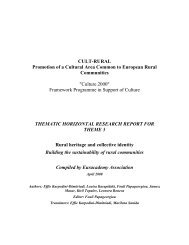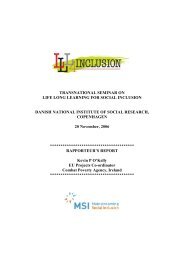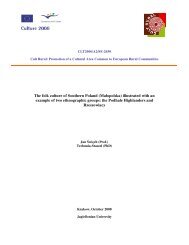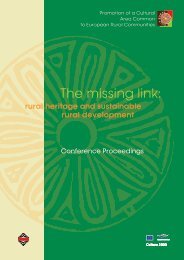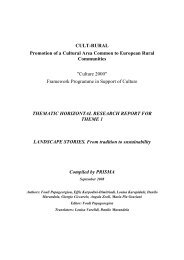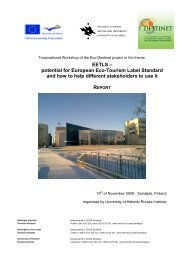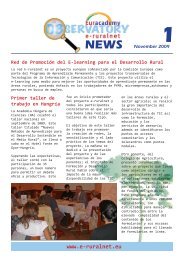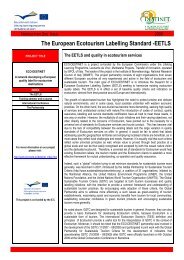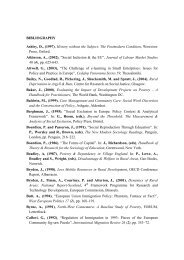ÐÐ¾Ð´Ð°Ñ Ð¿Ð¾ изложбаÑа - cult rural - Prisma
ÐÐ¾Ð´Ð°Ñ Ð¿Ð¾ изложбаÑа - cult rural - Prisma
ÐÐ¾Ð´Ð°Ñ Ð¿Ð¾ изложбаÑа - cult rural - Prisma
Create successful ePaper yourself
Turn your PDF publications into a flip-book with our unique Google optimized e-Paper software.
RITES OF PASSAGE<br />
The last stage of the “passage” is the act of removing the bride’s veil and of<br />
taking her wreath off – the change in her social status brings too a change in her<br />
clothes, adornments and headdress.<br />
INTERPRETING RURAL CUSTOMS AND RITUALS<br />
Celebrations and rituals have a central position in <strong>rural</strong> communities reinforcing<br />
the process of social identity building. Many of these are strong even in our<br />
days, providing an opportunity to members of a community to meet and rejoice<br />
together.<br />
relations between the individual and the whole are de-constructed, suggest that<br />
a return to traditional social values can give heed to an important lesson, that of<br />
integration; integration of the individual into the group, of art into everyday life, of<br />
death into life, of the body into existence, of nature into <strong>cult</strong>ure. It is not strange<br />
that in the post modern societies two <strong>cult</strong>ural notions coexist: ‘tradition’ and<br />
‘modernity’; once antagonists, but now important for development. It is the main<br />
problem of development to transform these contradictions into complementarities<br />
and permit people to become more active and act less as mere observers and at<br />
the end become more human.<br />
All customs and rituals described above and illustrated by the objects and the<br />
related material of the exhibition show, in the most striking way, that beyond<br />
differences and multiplicity all these rites have common elements that form the<br />
common European heritage. They also refl ect not only the wealth of <strong>rural</strong> <strong>cult</strong>ural,<br />
but also similarities that bind <strong>rural</strong> <strong>cult</strong>ures together and can strengthen their<br />
values towards a sustainable future for <strong>rural</strong> communities.<br />
In contemporary, multi<strong>cult</strong>ural societies, in which there is a strong need to<br />
reinforce the inter<strong>cult</strong>ural dialogue, the various values of <strong>rural</strong> communities<br />
(intellectual, ethical, aesthetic) can contribute to <strong>cult</strong>ural and social balance.<br />
Traditional <strong>cult</strong>ures are not only able to offer elements that help us to understand<br />
‘the other’, but can also direct people towards social forms that do not isolate,<br />
but, on the contrary, help them to function as members of the social entity.<br />
The experience of post-modern societies, in which values are confused and the<br />
44<br />
83. 84. 85. 86.<br />
83. Traditional costume of Sarakatsani woman<br />
from Komotini, Thrace, Greece<br />
84. Traditional costume of Sarakatsani man<br />
from Komotini, Thrace, Greece<br />
85. Women’s costumes (bride), the Krakowiak<br />
Folk (“Resovia Saltans” , Rzeszów), Poland<br />
86. Man’s costumes (groom), the Krakowiak<br />
Folk (“Resovia Saltans”, Rzeszów), Poland<br />
87. Woman’s costume from Pleven region,<br />
Bulgaria<br />
88. Man’s costume from Sofi a region, Bulgaria




